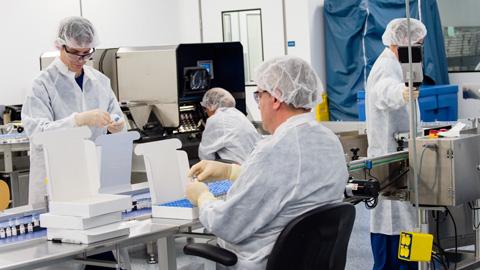Over the past 12 months, we’ve grown accustomed to seeing Zika in the news. The virus has been linked to thousands of cases of microcephaly in Brazilian babies. Numerous countries, including the United States, have reported Zika-related deaths. And there is no vaccine available at this time.
In the face of what has become a global health crisis, the Vaccine Research Center (VRC) at the NIH/National Institute of Allergy and Infectious Diseases (NIAID) responded to a call from Anthony Fauci, M.D., head, NIAID, to get a candidate vaccine into human trials by the summer of 2016.
Researchers chose to leverage platform knowledge in DNA-based vaccines and initiate candidate evaluations using both in vitro and in vivo models. In parallel, the Frederick National Laboratory for Cancer Research (FNLCR) devised a plan to manufacture and release good manufacturing practice (GMP) bulk and vialed drug product for the Phase I and II clinical studies.
The Vaccine Clinical Materials Program (VCMP) at FNLCR developed an “accelerated” schedule to produce, test, and release a vialed drug product by July 21, 2016. Because multiple vaccine candidates were being evaluated by the VRC, the planning stages required agility and flexibility.
On April 15, the VCMP received the first genetic construct—one of several Zika vaccine candidates—to take forward into GMP production in the VCMP Pilot Plant in Frederick, Maryland.
Because the Pilot Plant had not manufactured plasmid DNA (pDNA)–based vaccines for some time, training personnel and developing curricula specific to the Zika process were crucial for a successful delivery. Demonstrating the process at a 15-liter fermentation scale, prior to executing GMP production at a 100L scale, was also deemed necessary in order to confirm fermentation process performance and to identify opportunities to maximize yield.
Extensive documentation (from batch records to certificates of analysis) is required to support the execution and closeout of the campaign to produce materials for the U.S. Phase I clinical trial. Meanwhile, because of the potential for Phase II clinical trials in EU countries, the fill/finish group revised the aseptic manufacturing process to include additional samples in order to comply with EU regulatory expectations.
The first Zika pDNA batch was successfully filled into vials on June 15 (approximately 60 days after receipt of the final candidate starting material), and 664 doses were released to the VRC—approximately twice the Phase I trial requirement—on July 20 (about 90 days from first candidate receipt). The investigational new drug (IND) application was filed with the FDA on July 21, and clinical materials were shipped to the NIH Clinical Center the week of July 25. The FDA accepted the IND on August 1, and the first dosing of human subjects in a Phase I study commenced on August 2.
The Pilot Plant is on course to produce several thousand clinical doses over the course of multiple planned batches, including yield improvements that have already been realized in the second production batch. A second genetic construct is also in hand for which clinical materials are currently being produced. These materials will supply planned Phase I clinical trials under a separate IND application.
In collaboration with the Clinical Monitoring Research Program, VCMP is anticipating over 90 clinical shipments to clinical sites in at least six countries, including the United States, Brazil, the Dominican Republic, Puerto Rico, Martinique, and Guadeloupe. These shipments will support near-future Phase II clinical trials, currently in the planning stages.


